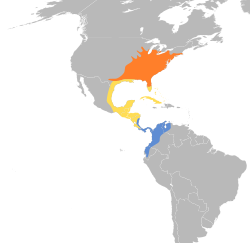Taxonomy
Originally described in 1810 by ornithologist Alexander Wilson, its first scientific name was Muscicapa querula. [5] The Acadian flycatcher is the only member of its clade within Empidonax , but is most closely related to willow and alder flycatchers. [6]
Because of the similar appearance of the Empidonax flycatchers, the Acadian flycatcher owes its name to a misidentified type specimen for the species, taken in the historic Acadia region of Nova Scotia. [7] Despite its common name, the Acadian flycatcher does not have a native range in Nova Scotia or historic Acadia. [8]
Distribution
Its breeding habitat is deciduous forests, often near water, across the eastern United States and southwestern Ontario. These birds migrate through eastern Mexico and the Caribbean to southern Central America and the very northwest of South America in Colombia, western Venezuela, and Ecuador.
The numbers of these birds have declined somewhat in the southern parts of their range. Brown-headed cowbirds lay eggs in the nests of these birds in some areas. However, only 16% of cowbird young in Acadian flycatcher nests fledge successfully.
They wait on a perch in the middle of a tree and fly out to catch insects in flight (hawking), also sometimes picking insects from foliage while hovering (gleaning). They may eat some berries and seeds.
They make a loose, shallow nest in a horizontal forks of trees and shrubs, primarily in lowland forests and marshy areas. [9]
The Acadian flycatcher is an excellent flier; it is extremely maneuverable, can hover, and can even fly backward. There is no scientific information on hopping or walking by this bird. [10]
As of October 2015 there have been 2 records of Acadian flycatcher in Europe, the first being a bird found dead in Iceland in 1967, [11] and the second a bird found on the beach at Dungeness in Kent, England in September 2015, [12] the latter's identity being established by DNA from its droppings. [13]
This page is based on this
Wikipedia article Text is available under the
CC BY-SA 4.0 license; additional terms may apply.
Images, videos and audio are available under their respective licenses.


